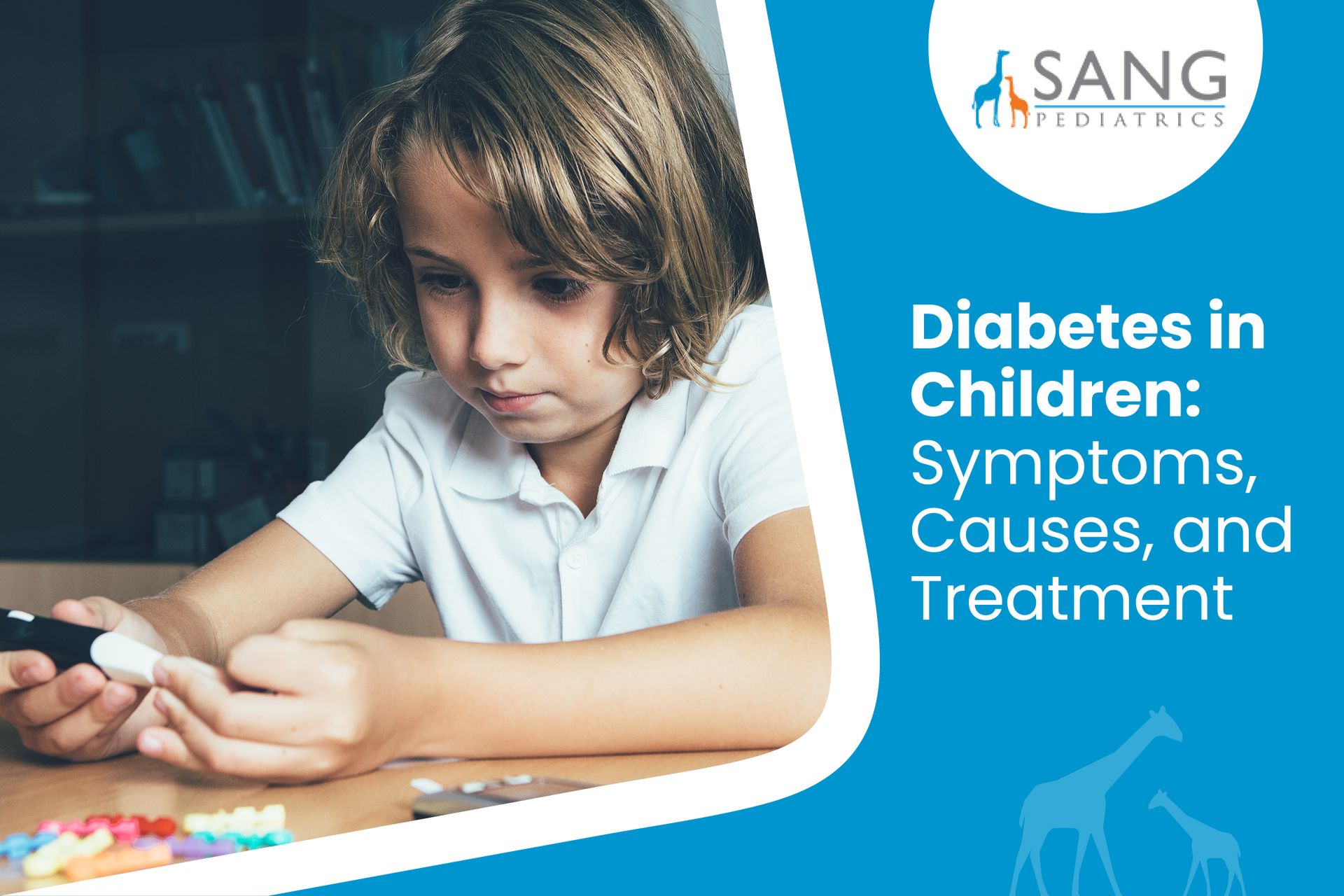Diabetes in Children: Symptoms, Causes, and Treatment

The symptoms, diagnosis, and treatment of diabetes are similar for children and adults. It may, however, be more challenging to manage diabetes in children. To maintain a suitable diet, you must consider a child's physical and emotional maturity level, along with constant variations in their food consumption, physical activity, and stress levels.
This blog will discuss diabetes in children, its symptoms, causes, and treatments.
What is Diabetes?
Diabetes is more commonly used to refer to diabetes mellitus. This metabolic disorder affects how your child's body utilizes blood sugar (blood glucose or just glucose). The supply of energy required by body cells is blood sugar. It fuels the tissues, muscles, and glands, including the brain.
Ingestion of proteins, fats, and carbohydrates provides glucose for the body as fuel. In this condition, insulin production is insufficient, preventing glucose from entering cells from circulation. The pancreas, an organ situated behind the stomach, produces insulin.
Further, if you want to learn, "how many types of diabetes are there?" Diabetes has three types: types 1 and 2, and gestational, which happens during pregnancy. However, this article will discuss the types that only affect children.
Diabetes mellitus is a metabolic disorder that affects how your child's body uses blood sugar (or glucose) as an energy source. Glucose fuels various tissues, muscles, glands, and even the brain, which makes it an essential nutrient. The body obtains glucose from proteins, fats, and carbohydrates, broken down into sugar molecules.
However, in diabetes, there is insufficient production of insulin, which is responsible for moving glucose from the bloodstream into the cells that need it. Insulin is produced by the pancreas, an organ located behind the stomach.
When glucose cannot enter the cells, it forms in the bloodstream, leading to high blood. If you’re wondering, “how many types of diabetes are there?” Diabetes has three primary types: type 1, type 2, and gestational diabetes, which occurs during pregnancy. However, this article will focus on the kinds that only affect children.
Symptoms of Diabetes in Children
Signs of diabetes in children can have different symptoms depending on the type of diabetes they have. Here are the symptoms:
1. Frequent Urination
Polyuria, or frequent urination, helps the body eliminate excess glucose. When your child has childhood diabetes type 1 or 2 diabetes, they often need to urinate more frequently, especially at night.
2. Increased Thirst
You, as parents, must be aware of children's diabetes symptoms, such as Polydipsia, also called increased thirst. The extra glucose in the bloodstream pulls water from the tissues, making your child with type 1 diabetes thirstier.
3. Extreme Hunger
Despite eating normally, children with type 1 diabetes can always feel hungry. Your child will experience Polyphagia or increased hunger, which makes up for the loss of glucose from constant urination.
4. Weight Loss
When your child has pediatric diabetes, their kidneys labor to eliminate extra sugar through urine when blood glucose levels rise. This causes weight loss due to dehydration and sugar calories lost. Children with type 1 diabetes frequently drop weight despite having a normal or increased appetite.
5. Fatigue
Children with type 1 and 2 diabetes will feel tired and have low energy levels. Blood sugar changes affect your child's energy.
6. Blurred Vision
Diabetes types 1 and 2 can cause blurred vision. The eye's lens can swell under high blood sugar conditions, impairing vision.
7. Mood Changes
Signs of diabetes in toddlers include mood changes. Your child with Type 1 diabetes experiences high and low blood sugar levels. Due to fluctuation, they become irritable and disoriented.
8. Yeast Infections
Girls with type 1 diabetes can have frequent yeast infections. Although not severe, they experience itching, burning, and a clumpy whitish discharge.
9. Slow-Healing Sores or Frequent Infections
Childhood type 2 diabetes can have slower healing or frequent infections. High blood glucose levels cause both poor blood flow and impaired natural recovery. Your child with diabetes
can experience slow-healing wounds, particularly on the feet.
Causes of Diabetes in Children
Genetic and environmental variables contribute to the causes of diabetes in children.
1. Diabetes Type 1
Type 1 diabetes causes are unclear. Almost certainly, it is an autoimmune disease. This occurs when the immune system wrongly attacks and destroys healthy tissue.
An infection or other factor causes type 1 diabetes by attacking the pancreas' insulin-producing beta cells. As parents, you can pass on autoimmune ailments like type 1 diabetes.
2. Diabetes Type 2
Type 2 diabetes mellitus is a highly prevalent type of diabetes. Obesity, inactivity, and a poor diet are some examples of lifestyle variables contributing to type 2 diabetes and genetics.
It is important to note that the most common form of diabetes is Type 2. If your child has type 2 diabetes, their body either stops responding to insulin or stops making enough of it to keep blood sugar levels regular.
3. Additional Forms of Diabetes
Children can develop monogenic diabetes and diabetes linked to cystic fibrosis, among other forms of diabetes. Gene mutations passed autosomal dominantly. This leads to monogenic diabetes.
Genetic diseases such as cystic fibrosis, which impacts the lungs, pancreas, and other organs, can cause diabetes.
How to Treat Diabetes in Children?
Treating diabetes in children requires a collaborative approach between you, your child, and the healthcare team. Treatment includes methods that will control blood sugar levels.
1. Lifestyle Changes
Lifestyle change is crucial for your child with diabetes.
- Diet: A change in diet is vital. Children with diabetes must eat a diet low in sugar and fiber. A dietitian can help create a meal plan tailored to your child's needs.
- Exercise: Encourage regular physical activity of 60 minutes daily for your child. This is essential for children with diabetes to help regulate blood sugar levels. It is vital to work with the child's healthcare team to determine the appropriate level of physical activity for them.
- Monitoring blood sugar levels: You should monitor your child's blood sugar levels regularly, as directed by their healthcare provider.
2. Medications
Insulin is the most common medication used to treat diabetes in children. The type of insulin and dosage will depend on your child's age, weight, and other factors. Pumps and injections are both options for administering insulin.
The child's needs can also dictate using other medications, such as metformin.
3. Regular Check-ups
Children with diabetes require regular check-ups with their healthcare provider to monitor their blood sugar levels, adjust their medications if necessary, and screen for potential complications.
4. Emotional Support
Children with diabetes can experience emotional stress and anxiety related to their condition. Emotional support plays an important role. It helps if you provide emotional support and resources, such as counseling.
Manage Your Child's Diabetes With the Medical Professionals
Visit our skilled physicians for early diabetes diagnosis and treatment, which can help avoid complications and enable your child to lead a healthy, active life. You can find Sang Pediatrics by searching for "pediatricians near me" or "Pediatric clinics in Fresno, California."
To schedule an interview, please contact us at (559) 268-1737.
Looking for more information?
Book a consultation
We are a pediatric primary care provider for the Fresno and Clovis area. We provide multiple pediatric services for your child's healthcare. We are also available for walk-ins during our regular business hours at any of our locations.
QUICK LINKS
Sang Pediatrics | All Rights Reserved.










